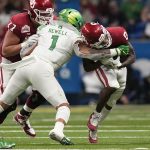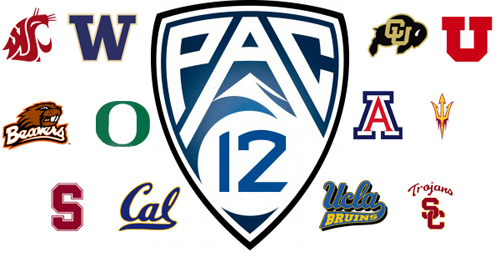On Feb. 2, Pac-12 commissioner George Kliavkoff appeared on a sports business podcast and laid out, in blunt terms, his strategy for securing a media rights contract — specifically with regard to the crucial question of content access.
“Whatever deal we do,” he explained, “it’s my goal to have our content available on any piece of glass connected to the internet. Period, full stop.”
Kliavkoff has kept an extremely low profile for months while negotiating a contract. If you were unaware of the comments on the Navigate sports business podcast, that’s entirely understandable. The interview took place on Feb. 2 … 2022.
His strategy has been hidden in plain sight for 55 weeks, folks.
It was set long before USC and UCLA bolted for the Big Ten, long before the Big 12 renewed its agreement with ESPN and Fox, long before the UC Regents spent months evaluating UCLA’s move and many, many months before the economy softened.
Kliavkoff reiterated the mission in September. During an appearance on ‘Canzano and Wilner: The Podcast,’ he offered: “We really want our content to be available to any of our fans who want to see it. I’ve set a goal that our content should be available to any piece of glass connected to the internet.”
Five months later, Kliavkoff is under mounting pressure to craft a media rights deal acceptable to the 10 remaining schools.
For all the rumors of a streaming-heavy contract — and accompanying speculation that such a deal would lead to the dissolution of the conference — the specifics remain a mystery.
Will a significant percentage of Pac-12 football and men’s basketball games be available on traditional linear platforms like ESPN? Will the majority be delivered by a streaming company like Apple or Amazon? Could every ounce of inventory be streamed?
For all the uncertainty, this much is clear: Kliavkoff’s strategy is a direct result of decade-long frustration over the Pac-12 Networks’ horrendous distribution.
Kliavkoff took charge on July 1, 2021 and soon began touring the campuses. At every stop, he spoke to athletes and coaches, administrators and executives. A constant complaint: The lack of access to the Pac-12 Networks, which were not on DirecTV, not in hotels, not in sports bars and not on many cable systems outside the conference. (Currently, they have approximately 14 million subscribers, a paltry number compared to the Big Ten and SEC networks.)
From there came the strategy: Kliavkoff would make sure Pac-12 football and basketball content was widely available.
He never specified which companies or services would distribute that content, but given the choice of words — “any piece of glass connected to the internet” — we can presume had streaming in mind.
During his remarks at Pac-12 football media day last July, he noted that the forthcoming distribution deal was “highly likely” to involve a major digital media company.
“We already have significant interest from potential partners,” he said, “including both incumbents and new traditional television and most importantly, digital media partners.”
Was that Amazon or Apple? Was it a reference to ESPN+? Is there another streaming company interested in Pac-12 content, one whose identity has been kept secret all these months?
Only an extremely tight circle of conference executives know for sure.
However, we can provide some context on potential outcomes.
In the current media contract, 28 percent of Pac-12 football games are distributed on Disney platforms (ABC, ESPN, ESPN2 and ESPNU).
We know this because the Pac-12 owns approximately 80 games each year: 54 regular-season conference matchups, the championship game, and about 25 non-conference home games. (That number varies slightly by the season, of course.)
ESPN and Fox license 45 of them as co-partners: 22 each, with the championship game alternating annually. So in a two-year cycle, ESPN/ABC has 45 of the 160, or 28 percent.
The other 35 games (approximately) — that’s about 44 percent of the total inventory — are distributed by the Pac-12 Networks.
Yep, almost half the games are on the outlet with the lowest visibility. And not by a little.
As broadcast networks, ABC and FOX are in about 120 million homes.
ESPN and FS1 reach about 75 million homes.
The Pac-12 Networks are in about 14 million.
That’s a heck of a business strategy.
It’s also the source of deep frustration across the Pac-12 footprint … and the foundation for Kliavkoff’s goal of making every game available on any device connected to the internet.
Throughout the media rights saga, the Hotline has made three basic assumptions:
— The Pac-12 Networks will cease to exist as a media distribution company — they won’t air any football or men’s basketball games.
— Disney’s linear networks (ABC, ESPN and ESPN2) will broadcast Pac-12 football. Exactly how much? Our guess is roughly the same percentage of games as in the current agreement.
(Key point: If the Pac-12 doesn’t expand, there will be 13-15 fewer games available.)
— A significant portion of Pac-12 football will be available on a streaming service.
We don’t know which one, of course. Nor do we know the exact number of domestic subscribers for each.
But to give you a sense of the reach of streaming compared to the cable networks (ESPN and FS1) and the Pac-12 Networks, we found these estimates online:
Prime Video: 77 million
Paramount (CBS): 56 million
Hulu (Disney): 48 million
Apple TV: 30 million
ESPN+: 25 million
Peacock: 15 million
Even ESPN+ and Apple TV, potential landing spots for Pac-12 content, have approximately twice as many subscribers as the Pac-12 Networks.
And they are available on any piece of glass connected to the internet.
Our view is that a streaming-only deal could look smart in the late stages of the next media contract cycle — the final years of the 2020s, essentially — but it would carry near- and intermediate-term risks and might be met with resistance from the schools.
The conference needs its premier football games to be widely and easily available, and linear platforms provide that access.
(It makes no difference if the content is licensed directly from the conference or through a sub-licensing arrangement with a streaming company.)
What’s more, a financial arrangement with ESPN would help ensure that its narrative-setting studio shows discuss Pac-12 teams, coaches and players on a regular basis.
We suspect the media rights process will be resolved next month but don’t know how it will play out, particularly with regard to Kliavkoff’s streaming strategy.
The goal here is simply to explain it.
*** Send suggestions, comments and tips (confidentiality guaranteed) to pac12hotline@bayareanewsgroup.com or call 408-920-5716
*** Follow me on Twitter: @WilnerHotline
*** Pac-12 Hotline is not endorsed or sponsored by the Pac-12 Conference, and the views expressed herein do not necessarily reflect the views of the Conference.
Related posts:
 Hotline Mailbag – Defining Blue Bloods, Oregon Football Recruiting, more…
Hotline Mailbag – Defining Blue Bloods, Oregon Football Recruiting, more…  Wilner Hotline – NFL Draft winners and losers, the Pac-12 perspective
Wilner Hotline – NFL Draft winners and losers, the Pac-12 perspective 
(AP Photo/Eric Gay)
Pac-12 football: Ranking the top prospects for the 2023 NFL Draft Wilner Hotline – Pac-12 football 2022 win totals: Our breakdown of the schedules
Wilner Hotline – Pac-12 football 2022 win totals: Our breakdown of the schedules
